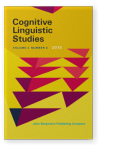Vol. 2:2 (2015) ► pp.302–329
Thinking-for-translating
Acquisition of English physical motion constructions by Spanish translators in training
The present paper examines the acquisition of English physical motion constructions by Spanish translators in training. Drawing from Talmy’s (1985, 1991, 2000) typological framework for motion event descriptions and Slobin’s (1996, 2003) thinking-for-speaking hypothesis, the main aim of this research is to study whether the acquisition of English lexicalization patterns by Spanish translators in training could be facilitated by instructing them to think-for-translating into English. To this end, first, participants in the experimental and control group were told to translate some narrative fragments from Spanish into English. Then, once they completed the task, participants in the experimental group were instructed on the typological differences between English and Spanish with regard to the domain of physical motion and on how to render typical Spanish motion descriptions into English motion constructions. Finally, after a one week delay they were told to translate new fragments from Spanish into English. We observed that participants in the experimental group produced a higher number of manner verbs plus path expressions than the control group which, in turn, favoured the use of non-manner verbs plus path expressions. The results show that, overall, instruction contributes to better performance in the production of satellite-framed constructions but translators in training still have problems with the use of satellites and prepositional phrases.
